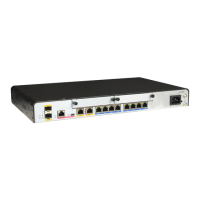The system view is displayed.
Step 2 Run:
acl acl-number
The ACL view is displayed.
Step 3 Run:
rule [ rule-id ] { deny | permit } [ { fragment | none-first-fragment } | source
{ source-address source-wildcard | any } | time-range time-name | vpn-instance vpn-
instance-name ]
*
The ACL rule is configured.
NOTE
By default, the deny action in an ACL rule is taken for all the packets. To allow packets to pass through,
define the permit action in the ACL rule. For example, to discard packets with the source IP address of
10.1.1.10, define two rules in an ACL:
l rule deny source 10.1.1.10 0
l rule permit source any
If rule permit source any is not defined, packets with other source IP addresses but not 10.1.1.10 0 are
also discarded.
Step 4 Run:
quit
The system view is displayed.
Step 5 Run the tftp-server acl acl-number command. You can use the ACL to limit the access to the
TFTP server.
----End
8.4.4 Downloading Files Using TFTP
You can download files from a TFTP server to a TFTP client.
Do as follows on the router that serves as the TFTP client:
Procedure
l Run:
tftp [ -a source-ip-address | -i interface-type interface-number ] tftp-
server [ public-net | vpn-instance vpn-instance-name ] get source-filename
[ destination-filename ]
The router is configured to download files using TFTP.
----End
8.4.5 Uploading Files Using TFTP
You can upload files from a TFTP client to a TFTP server.
Do as follows on the router that serves as the TFTP client:
Huawei AR1200 Series Enterprise Routers
Configuration Guide - Basic Configuration 8 Accessing Another Device
Issue 04 (2012-05-15) Huawei Proprietary and Confidential
Copyright © Huawei Technologies Co., Ltd.
156

